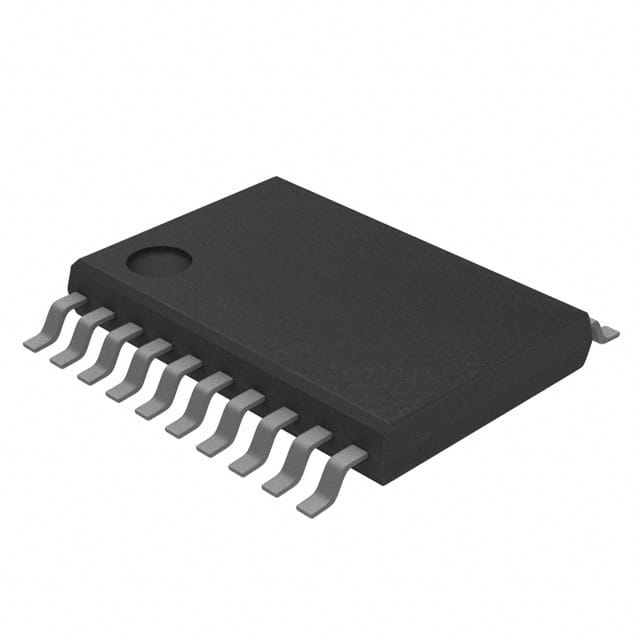SN74LV245ATPWT
Product Overview
- Category: Integrated Circuit
- Use: Level Shifter/Transceiver
- Characteristics: Low-voltage, Octal Bus Transceiver with 3-State Outputs
- Package: TSSOP (Thin Shrink Small Outline Package)
- Essence: The SN74LV245ATPWT is a level shifter and transceiver integrated circuit that allows bidirectional voltage translation between different logic levels.
- Packaging/Quantity: Tape and Reel, 2500 pieces per reel
Specifications
- Supply Voltage Range: 1.65V to 5.5V
- High-Level Input Voltage: 2V to VCC + 0.5V
- Low-Level Input Voltage: -0.5V to 0.8V
- High-Level Output Voltage: VCC - 0.5V
- Low-Level Output Voltage: 0.4V
- Maximum Input Current: ±10mA
- Maximum Output Current: ±32mA
- Operating Temperature Range: -40°C to 85°C
Detailed Pin Configuration
The SN74LV245ATPWT has a total of 20 pins. The pin configuration is as follows:
- DIR (Direction Control)
- OE (Output Enable)
- A1 (Data Input/Output)
- B1 (Data Input/Output)
- A2 (Data Input/Output)
- B2 (Data Input/Output)
- A3 (Data Input/Output)
- B3 (Data Input/Output)
- A4 (Data Input/Output)
- B4 (Data Input/Output)
- GND (Ground)
- B5 (Data Input/Output)
- A5 (Data Input/Output)
- B6 (Data Input/Output)
- A6 (Data Input/Output)
- B7 (Data Input/Output)
- A7 (Data Input/Output)
- B8 (Data Input/Output)
- A8 (Data Input/Output)
- VCC (Supply Voltage)
Functional Features
- Bidirectional voltage translation between different logic levels
- 3-state outputs for bus-oriented applications
- Low-voltage operation compatible with various logic families
- High-speed operation, suitable for high-frequency applications
- ESD protection on all inputs and outputs
- Power-up 3-state feature prevents bus contention during power-up
Advantages and Disadvantages
Advantages: - Allows interfacing between different logic level devices - Provides bidirectional data transfer capability - Supports high-speed operation - Offers ESD protection on all inputs and outputs - Prevents bus contention during power-up
Disadvantages: - Limited to a maximum supply voltage of 5.5V - May not be suitable for applications requiring higher voltage levels
Working Principles
The SN74LV245ATPWT operates by receiving data from one set of pins (A1-A8) and transmitting it to another set of pins (B1-B8) when the direction control pin (DIR) is set accordingly. The output enable pin (OE) allows the device to enter a high-impedance state, effectively disconnecting the input and output pins.
The integrated circuit uses level-shifting techniques to ensure proper voltage translation between different logic levels. It is designed to operate at low voltages, making it compatible with various logic families.
Detailed Application Field Plans
The SN74LV245ATPWT is commonly used in applications where voltage translation is required between different logic levels. Some specific application fields include:
- Microcontroller interfacing: The IC enables communication between microcontrollers operating at different voltage levels.
- Sensor interfaces: It facilitates data transfer between sensors and microcontrollers with varying logic voltage requirements.
- Communication systems: The device is used in level shifting applications within communication systems, such as UART, SPI, or I2C interfaces.
- Industrial automation: It finds application in industrial control systems where different devices operate at different voltage levels.
Detailed and Complete Alternative Models
- SN74LVC245APW: Similar to SN74LV245ATPWT but operates at a wider supply voltage range of 1.65V to 3.6V.
- SN74HCT245N: A non-inverting octal bus transceiver that operates at higher voltage levels (up to 5.5V).
- SN74LVCH245ADGVR: Another low-voltage octal bus transceiver with 3-state outputs, compatible with various logic families.
These alternative models offer similar functionality to the SN74LV245ATPWT but may have different specifications and pin configurations.
기술 솔루션에 SN74LV245ATPWT 적용과 관련된 10가지 일반적인 질문과 답변을 나열하세요.
Sure! Here are 10 common questions and answers related to the application of SN74LV245ATPWT:
Question: What is SN74LV245ATPWT?
- Answer: SN74LV245ATPWT is a type of octal bus transceiver with 3-state outputs, commonly used in digital systems.Question: What is the voltage range supported by SN74LV245ATPWT?
- Answer: SN74LV245ATPWT supports a voltage range of 1.65V to 5.5V.Question: How many bidirectional channels does SN74LV245ATPWT have?
- Answer: SN74LV245ATPWT has 8 bidirectional channels.Question: Can SN74LV245ATPWT be used for level shifting between different voltage domains?
- Answer: Yes, SN74LV245ATPWT can be used for level shifting between different voltage domains.Question: What is the maximum data transfer rate supported by SN74LV245ATPWT?
- Answer: SN74LV245ATPWT supports a maximum data transfer rate of 100Mbps.Question: Does SN74LV245ATPWT have built-in ESD protection?
- Answer: Yes, SN74LV245ATPWT has built-in ESD protection.Question: Can SN74LV245ATPWT be used in both parallel and serial communication interfaces?
- Answer: Yes, SN74LV245ATPWT can be used in both parallel and serial communication interfaces.Question: What is the power supply voltage required for SN74LV245ATPWT?
- Answer: SN74LV245ATPWT requires a power supply voltage of 2.7V to 5.5V.Question: Can SN74LV245ATPWT be used in both input and output mode?
- Answer: Yes, SN74LV245ATPWT can be used in both input and output mode.Question: Is SN74LV245ATPWT compatible with other logic families like TTL or CMOS?
- Answer: Yes, SN74LV245ATPWT is compatible with other logic families like TTL or CMOS.
Please note that these answers are general and may vary depending on the specific application and requirements.


